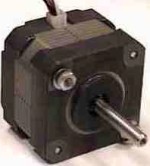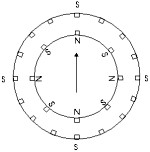
 Search Here
Search Here
MISC
Parts List
Robot Forum
Chat
Member Pages
Axon MCU
Robot Books
Shop
Contact
SKILLS
How To Build
A Robot
Tutorial
Calculators
Mechanics
Programming
Miscellaneous
Robots
Space
HARDWARE
Actuators
Batteries
Electronics
Materials
Microcontrollers
Sensors
SCIENCE
Robot Journals
Robot Theory
Conferences
- Stepper motors can be easily found in any 3.5" disk drive
- Require special stepper motor controllers
- Have a set resolution, higher resolutions mean higher accuracy but lower holding torque
- If torque applied to stepper is greater than holding torque, stepper will lose accurate position measurements
- Polarized (current cannot be reversed)
- Typically from 5-12V, but can range to extremes in special application motors
- Higher voltages generally mean more torque, but also require more power
- Steppers can run above or below rated voltage (to meet other design requirements)
- Most efficient at rated voltage
- When buying a motor, consider stall, holding, and operating current (max and minimum)
- Stall Current - The current a stepper motor requires when powered but held so that it does not rotate
- Holding Current - The current a stepper motor requires when powered but not signaled to rotate
- Operating Current - The current draw when a stepper motor experiences zero resistance torque
- It is best to determine current curves relating voltage, current, and required torque for optimization
- When a stepper motor experiences a change in torque (such as motor reversal) expect short lived current spikes
- Current spikes can be up to 2x the stall current, and can fry control circuitry if unprotected
- Use diodes to prevent reverse current to your circuitry
- Check power ratings of your circuitry and use heat sinks if needed
- Running motors close to stall current often, or reversing current often under high torque, can cause motors to melt
- Heat sink motors if not avoidable
- When buying a stepper motor, consider stall and operating torque (max and minimum)
- Stall Torque - The torque a stepper motor requires when powered but held so that it does not rotate
- Holding Torque - The torque a stepper motor requires when powered but not signaled to rotate
- Operating Torque - The torque a stepper motor can apply when experiencing zero resistance torque
- Changing voltage will change torque
- Motors run most efficient at the highest possible speeds
- Gearing a motor allows the stepper motor to run fast, yet have a slower output speed with much higher torque
- Remember that torque determines acceleration, so a fast robot with poor acceleration is really a slow robot
- If uncertain, favor torque over velocity
- Stepper motors are slower than DC motors
- Most efficient at rated voltage
- Less efficient than DC motors due to non-continuous stepping
- Use gearing (opt to buy stepper motors with built-in gearing or gear heads)
- Stepper Motors require a special stepper controller
- More accurate (but not really accurate) control than a DC motor


note: this page is a place holder until a better tutorial is written
Note: A much nicer stepper motor tutorial can be found in the member tutorials:
Stepper Motor Member Tutorial
Stepper Motors work under a very similar principle to DC motors, except they have many coils instead of just one. So to operate a stepper motor, one must activitate these different coils in particular patterns to generate motor rotation. So stepper motors need to be sent patterned commands to rotate. These commands are sent as high and low logic over several lines, and must be pulsed in a particular order and combination. Steppers are often used because each 'step,' separated by a set step angle, can be counted and used for feedback control. For example, a 10 degree step angle stepper motor would require 36 commands to rotate 360 degrees. However external torque can force movement to a different step, invalidating feedback. Therefore external torque must never exceed the holding torque of a stepper.
Notes on Stepper Motors
Voltage
Current
Power (Voltage x Current)
Torque
Velocity
Efficiency
Control Methods
Society of Robots copyright 2005-2014